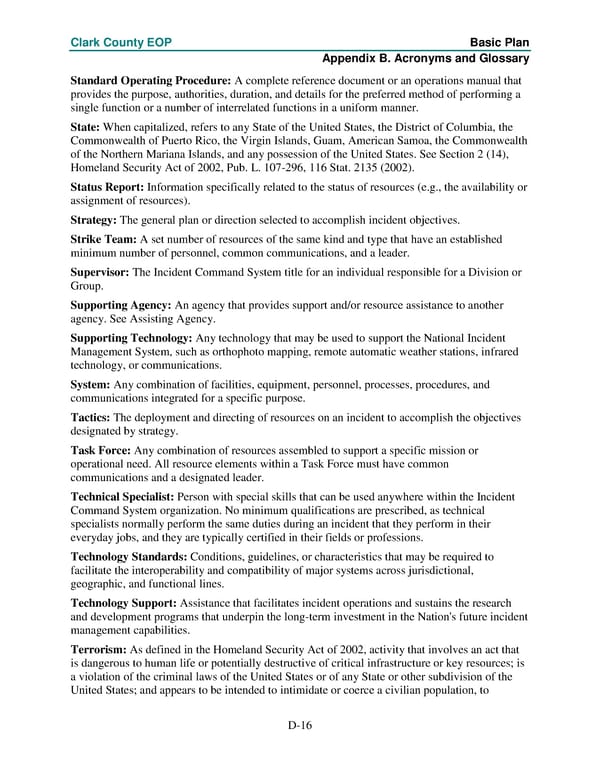Clark County EOP Basic Plan Appendix B. Acronyms and Glossary Standard Operating Procedure: A complete reference document or an operations manual that provides the purpose, authorities, duration, and details for the preferred method of performing a single function or a number of interrelated functions in a uniform manner. State: When capitalized, refers to any State of the United States, the District of Columbia, the Commonwealth of Puerto Rico, the Virgin Islands, Guam, American Samoa, the Commonwealth of the Northern Mariana Islands, and any possession of the United States. See Section 2 (14), Homeland Security Act of 2002, Pub. L. 107-296, 116 Stat. 2135 (2002). Status Report: Information specifically related to the status of resources (e.g., the availability or assignment of resources). Strategy: The general plan or direction selected to accomplish incident objectives. Strike Team: A set number of resources of the same kind and type that have an established minimum number of personnel, common communications, and a leader. Supervisor: The Incident Command System title for an individual responsible for a Division or Group. Supporting Agency: An agency that provides support and/or resource assistance to another agency. See Assisting Agency. Supporting Technology: Any technology that may be used to support the National Incident Management System, such as orthophoto mapping, remote automatic weather stations, infrared technology, or communications. System: Any combination of facilities, equipment, personnel, processes, procedures, and communications integrated for a specific purpose. Tactics: The deployment and directing of resources on an incident to accomplish the objectives designated by strategy. Task Force: Any combination of resources assembled to support a specific mission or operational need. All resource elements within a Task Force must have common communications and a designated leader. Technical Specialist: Person with special skills that can be used anywhere within the Incident Command System organization. No minimum qualifications are prescribed, as technical specialists normally perform the same duties during an incident that they perform in their everyday jobs, and they are typically certified in their fields or professions. Technology Standards: Conditions, guidelines, or characteristics that may be required to facilitate the interoperability and compatibility of major systems across jurisdictional, geographic, and functional lines. Technology Support: Assistance that facilitates incident operations and sustains the research and development programs that underpin the long-term investment in the Nation's future incident management capabilities. Terrorism: As defined in the Homeland Security Act of 2002, activity that involves an act that is dangerous to human life or potentially destructive of critical infrastructure or key resources; is a violation of the criminal laws of the United States or of any State or other subdivision of the United States; and appears to be intended to intimidate or coerce a civilian population, to D-16
 Emergency Operations Plan Page 119 Page 121
Emergency Operations Plan Page 119 Page 121